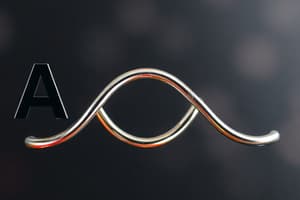Podcast
Questions and Answers
ما هي خصائص الرابطة المعدنية؟
ما هي خصائص الرابطة المعدنية؟
تمتلك الرابطة المعدنية خصائص مثل توصيل التيار الكهربائي والحرارة، والمرونة، وقابلية السحب والطرق، وقوة الرابطة
ما هو نموذج بحر الإلكترون؟
ما هو نموذج بحر الإلكترون؟
يفترض نموذج بحر الإلكترون أن إلكترونات التكافؤ في المعادن تتحرك بحرية بين ذرات المعادن.
تسمى الإلكترونات التي تتحرك بحرية في المعادن ______.
تسمى الإلكترونات التي تتحرك بحرية في المعادن ______.
إلكترونات مُمَوْضَعَة
ما هي الخصائص الفيزيائية للمعادن؟
ما هي الخصائص الفيزيائية للمعادن؟
السبائك هي مزيج من عنصرين معدنين على الأقل.
السبائك هي مزيج من عنصرين معدنين على الأقل.
ما هو نوع السبيكة التي يتم فيها استبدال بعض ذرات المعدن الأصلي بذرات معادن أخرى بحجم ذري مشابه؟
ما هو نوع السبيكة التي يتم فيها استبدال بعض ذرات المعدن الأصلي بذرات معادن أخرى بحجم ذري مشابه؟
ما هو نوع السبيكة التي تُشكل بإدخال ذرات صغيرة في الفراغات بينية بين ذرات المعدن الأصلي؟
ما هو نوع السبيكة التي تُشكل بإدخال ذرات صغيرة في الفراغات بينية بين ذرات المعدن الأصلي؟
ما هي الرابطة التساهمية؟
ما هي الرابطة التساهمية؟
ما هو الكهروسالبية؟
ما هو الكهروسالبية؟
ما هو نوع الرابطة التي تتكون عندما تكون الكهروسالبية بين الذرات كبيرة؟
ما هو نوع الرابطة التي تتكون عندما تكون الكهروسالبية بين الذرات كبيرة؟
الرابطة القطبية هي رابطة لها قطبان لهما شحنة مختلفة.
الرابطة القطبية هي رابطة لها قطبان لهما شحنة مختلفة.
ما هو نوع الرابطة التي تتكون بين ذرات متشابهة؟
ما هو نوع الرابطة التي تتكون بين ذرات متشابهة؟
ما هي القوى بين الجزيئية؟
ما هي القوى بين الجزيئية؟
ما هو نوع القوة بين الجزيئية التي تُؤثر بين جزيئات قطبية؟
ما هو نوع القوة بين الجزيئية التي تُؤثر بين جزيئات قطبية؟
ما هي أقوى أنواع القوى بين الجزيئية؟
ما هي أقوى أنواع القوى بين الجزيئية؟
تُؤثر قوة تشتت لندن بين جميع الجزيئات بغض النظر عن القطبية.
تُؤثر قوة تشتت لندن بين جميع الجزيئات بغض النظر عن القطبية.
ما هي فرضية النظرية الحركية الجزيئية؟
ما هي فرضية النظرية الحركية الجزيئية؟
ماذا تفسر النظرية الحركية الجزيئية؟
ماذا تفسر النظرية الحركية الجزيئية؟
تُعرف درجة الحرارة بكمية الحرارة التي يمتلكها الجسم.
تُعرف درجة الحرارة بكمية الحرارة التي يمتلكها الجسم.
ما هو قانون بويل؟
ما هو قانون بويل؟
ماذا يحدث لضغط الغاز عندما يضغط على حجمه؟
ماذا يحدث لضغط الغاز عندما يضغط على حجمه؟
ماذا يحدث لحجم الغاز عندما تُزداد درجة حرارته؟
ماذا يحدث لحجم الغاز عندما تُزداد درجة حرارته؟
ما هو قانون غاي-لوساك؟
ما هو قانون غاي-لوساك؟
قانون الغازات المجمعة يُجمع بين قوانين بويل وشارل وغاي-لوساك.
قانون الغازات المجمعة يُجمع بين قوانين بويل وشارل وغاي-لوساك.
ما هو مبدأ أفوجادرو؟
ما هو مبدأ أفوجادرو؟
ما هو حجم مول واحد من الغاز عند ظروف قياسية؟
ما هو حجم مول واحد من الغاز عند ظروف قياسية؟
ما هو قانون الغازات المثالي؟
ما هو قانون الغازات المثالي؟
ما هو ثابت الغازات المثالي؟
ما هو ثابت الغازات المثالي؟
ما هي العوامل التي تؤثر على سلوك الغازات الحقيقية؟
ما هي العوامل التي تؤثر على سلوك الغازات الحقيقية؟
ما هي الكيمياء الحيوية؟
ما هي الكيمياء الحيوية؟
لماذا تسمى إلكترونات التكافؤ في المعادن بإلكترونات غير موضعية؟
لماذا تسمى إلكترونات التكافؤ في المعادن بإلكترونات غير موضعية؟
Flashcards
رابطة فلزية
رابطة فلزية
قوة تجاذب بين أيونات فلزية موجبة وإلكترونات متحررة.
إلكترونات متحررة
إلكترونات متحررة
الإلكترونات في مستويات الطاقة الخارجية للذرات الفلزية التي تتحرك بحرية في الشبكة.
نموذج بحر الإلكترونات
نموذج بحر الإلكترونات
نموذج يصف كيف تتحرك الإلكترونات المتحررة في الشبكة المعدنية.
خواص فيزيائية للفلزات
خواص فيزيائية للفلزات
Signup and view all the flashcards
نقاط الانصهار والغليان للفلزات
نقاط الانصهار والغليان للفلزات
Signup and view all the flashcards
التوصيل الحراري والكهربائي للفلزات
التوصيل الحراري والكهربائي للفلزات
Signup and view all the flashcards
القابليّة للطرق والسحب
القابليّة للطرق والسحب
Signup and view all the flashcards
صلابة وقوة الفلزات
صلابة وقوة الفلزات
Signup and view all the flashcards
سبائك
سبائك
Signup and view all the flashcards
سبائك بديلة
سبائك بديلة
Signup and view all the flashcards
سبائك دخيلة
سبائك دخيلة
Signup and view all the flashcards
السلبية الكهربية
السلبية الكهربية
Signup and view all the flashcards
الرابطة التساهمية
الرابطة التساهمية
Signup and view all the flashcards
طابع الرابطة
طابع الرابطة
Signup and view all the flashcards
الرابطة القطبية
الرابطة القطبية
Signup and view all the flashcards
الرابطة غير القطبية
الرابطة غير القطبية
Signup and view all the flashcards
العدد الذرّي
العدد الذرّي
Signup and view all the flashcards
عدد الكتلة
عدد الكتلة
Signup and view all the flashcards
إلكترونات التكافؤ
إلكترونات التكافؤ
Signup and view all the flashcards
الخواص الكيميائية
الخواص الكيميائية
Signup and view all the flashcards
الخواص الفيزيائية
الخواص الفيزيائية
Signup and view all the flashcards
الفلزات
الفلزات
Signup and view all the flashcards
الرابطة المعدنية
الرابطة المعدنية
Signup and view all the flashcards
الإلكترونات المتحررة
الإلكترونات المتحررة
Signup and view all the flashcards
الخصائص الفيزيائية للفلزات
الخصائص الفيزيائية للفلزات
Signup and view all the flashcards
ما هو الفرق بين الرابطة الأيونية والرابطة التساهمية؟
ما هو الفرق بين الرابطة الأيونية والرابطة التساهمية؟
Signup and view all the flashcards
ما هي أهمية السلبية الكهربية في تحديد طابع الرابطة؟
ما هي أهمية السلبية الكهربية في تحديد طابع الرابطة؟
Signup and view all the flashcards
ما هي خصائص الفلزات؟
ما هي خصائص الفلزات؟
Signup and view all the flashcards
كيف تُشكل السبائك؟
كيف تُشكل السبائك؟
Signup and view all the flashcards
ما هي أنواع السبائك؟
ما هي أنواع السبائك؟
Signup and view all the flashcards
ما هو "نموذج بحر الإلكترونات"؟
ما هو "نموذج بحر الإلكترونات"؟
Signup and view all the flashcards
ما هي أهمية "الربط المعدني"؟
ما هي أهمية "الربط المعدني"؟
Signup and view all the flashcards
ما هي "الإلكترونات المت الحررة" في الفلزات؟
ما هي "الإلكترونات المت الحررة" في الفلزات؟
Signup and view all the flashcards
ما هي نقاط الانصهار و الغليان في الفلزات؟
ما هي نقاط الانصهار و الغليان في الفلزات؟
Signup and view all the flashcards
ما هي "السبائك"؟
ما هي "السبائك"؟
Signup and view all the flashcards
ما هي "السبائك البديلة"؟
ما هي "السبائك البديلة"؟
Signup and view all the flashcards
ما هي "السبائك الدخيلة"؟
ما هي "السبائك الدخيلة"؟
Signup and view all the flashcards
Study Notes
EoT Term 3 2023-2024 Chemistry Grade 10 Advanced
- Course content is for Term 3, 2023-2024
- Subject is Chemistry
- Grade level is 10 Advanced
Metallic Bonds
- In a metallic lattice, the outer energy levels of the metal atoms overlap.
- The electron sea model suggests that all metal atoms in a metallic solid contribute their valence electrons to form a "sea" of electrons that surrounds the metal cations in the lattice.
Delocalized Electrons
- Electrons in the outer energy levels of bonding metallic atoms are called delocalized electrons. They move freely from one atom to the next.
- When an atom's outer electrons move freely, a metallic cation is formed.
- A metallic bond is the attraction of a metallic cation for delocalized electrons.
Physical Properties of Metals
- The physical properties of metals at the bulk scale can be explained by metallic bonding.
- These properties are evidence of the strength of metallic bonds.
- Melting and boiling points
- Thermal and electrical conductivity
- Malleability, ductility, and durability
- Hardness and strength
Melting and Boiling Points of Metals
- Melting points of metals are less extreme than boiling points.
- This is because cations and electrons are mobile in a metal.
- Less energy is needed for them to move past each other.
- During boiling, atoms must completely separate from the lattice, requiring more energy.
Metal Properties (Conductivity, Malleability, and Ductility)
- Movement of mobile electrons around positive metallic cations makes metals good conductors.
- Mobile electrons quickly transfer heat from one place to another.
- Mobile electrons easily move as part of an electrical current when an electric potential is applied to a metal.
- Metals are malleable (can be hammered into sheets).
- Metals are ductile (can be drawn into wire).
- Applied force causes metal ions to move through delocalized electrons, making metals malleable and ductile.
Metals Durability
- Metals are durable.
- Metallic cations are strongly attracted to electrons around them and are not easily removed from the metal.
- Hardness and strength increase with the number of delocalized electrons.
Metal Alloys
- An alloy is a mixture of elements with metallic properties. -Examples: stainless steel, brass, cast iron
- Alloy properties generally differ from the properties of the constituent elements. -Example: Steel (iron mixed with other elements) is stronger than iron.
Covalent Bonds
- A covalent bond is formed when atoms share electrons.
- Electronegativity (EN) measures an atom's ability to attract electrons in a covalent bond.
- Bond character describes the bond type (ionic, polar covalent, or nonpolar covalent) based on electronegativity difference.
- Polar bonds contain oppositely charged regions.
- Nonpolar bonds possess no difference charges.
Electronegativity and Bond Character
- Electronegativity decreases going down a group and increases going across a period.
- The difference in electronegativity between bonded atoms determines the bond character.
- Ionic bonds form when the EN difference is greater than 1.7, and polar covalent bonds form when the difference is between 0.4 and 1.7.
- Nonpolar covalent bonds form when the difference is less than 0.4.
Polar Covalent Bonds
- Shared electrons in a polar bond are more attracted to one atom than the other.
- Partial charges result on the ends of the bond (dipoles).
- The electronegativity difference between the atoms determines the extent of polarity.
Molecular Polarity
- Covalently bonded molecules can be polar or nonpolar.
- Nonpolar molecules are not attracted to electric fields.
- Polar molecules align with electric fields.
- Molecular shape influences polarity.
Intermolecular Forces
- Covalent bonds are strong, but intermolecular forces (van der Waals forces) between molecules are weak.
- Intermolecular forces are attractions between covalent molecules, not atoms.
- Types of intermolecular forces include: dispersion forces, dipole-dipole forces, and hydrogen bonds.
Kinetic Molecular Theory
- Gases are composed of small particles.
- Gas particles are in constant, random motion.
- Collisions between gas particles are elastic.
Particle Energy
- Kinetic energy depends on mass and velocity.
- Temperature is a measure of the average kinetic energy of particles.
Gas Density
- Gases have low density because of the large amount of empty space between their particles.
Gas Compression and Expansion
- Changing the volume of a gas in a closed container affects its density.
Diffusion and Effusion
- Gases will flow past each other due to their lack of significant attractive forces, resulting in diffusion.
- Effusion occurs when a gas escapes through a tiny opening.
Graham's Law
- The rate of effusion or diffusion is inversely proportional to the square root of the molar mass.
Dalton's Law of Partial Pressures
- The total pressure of a mixture of gases is the sum of the partial pressures of each gas in the mixture.
- Partial pressure is independent of the type of gas at a given temperature and pressure.
The Ideal Gas Law
- The ideal gas law relates pressure, volume, temperature, and the number of moles of a gas.
- The ideal gas law is PV = nRT, where P is pressure, V is volume, n is the number of moles, R is the ideal gas constant, and T is temperature in Kelvin.
Studying That Suits You
Use AI to generate personalized quizzes and flashcards to suit your learning preferences.




